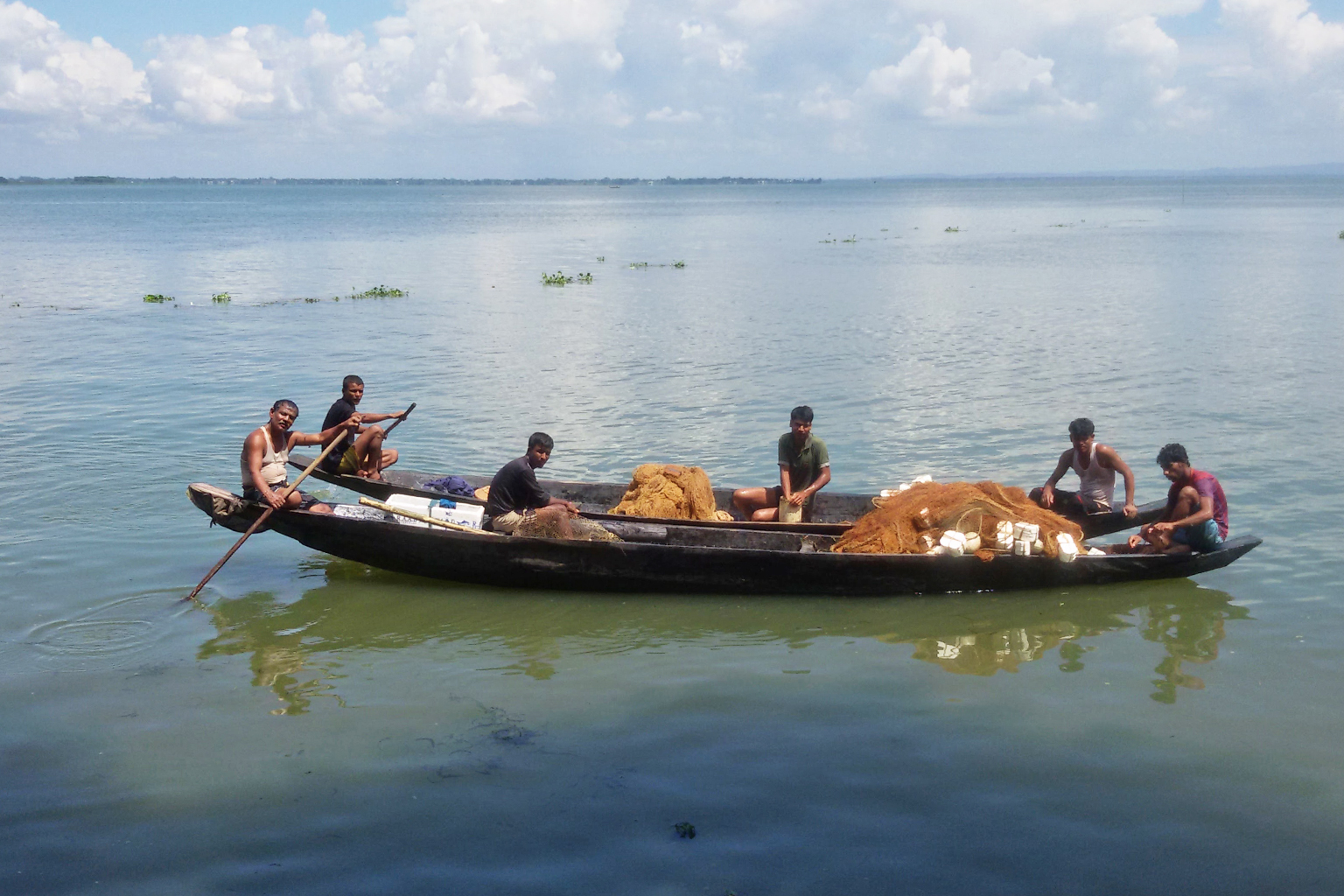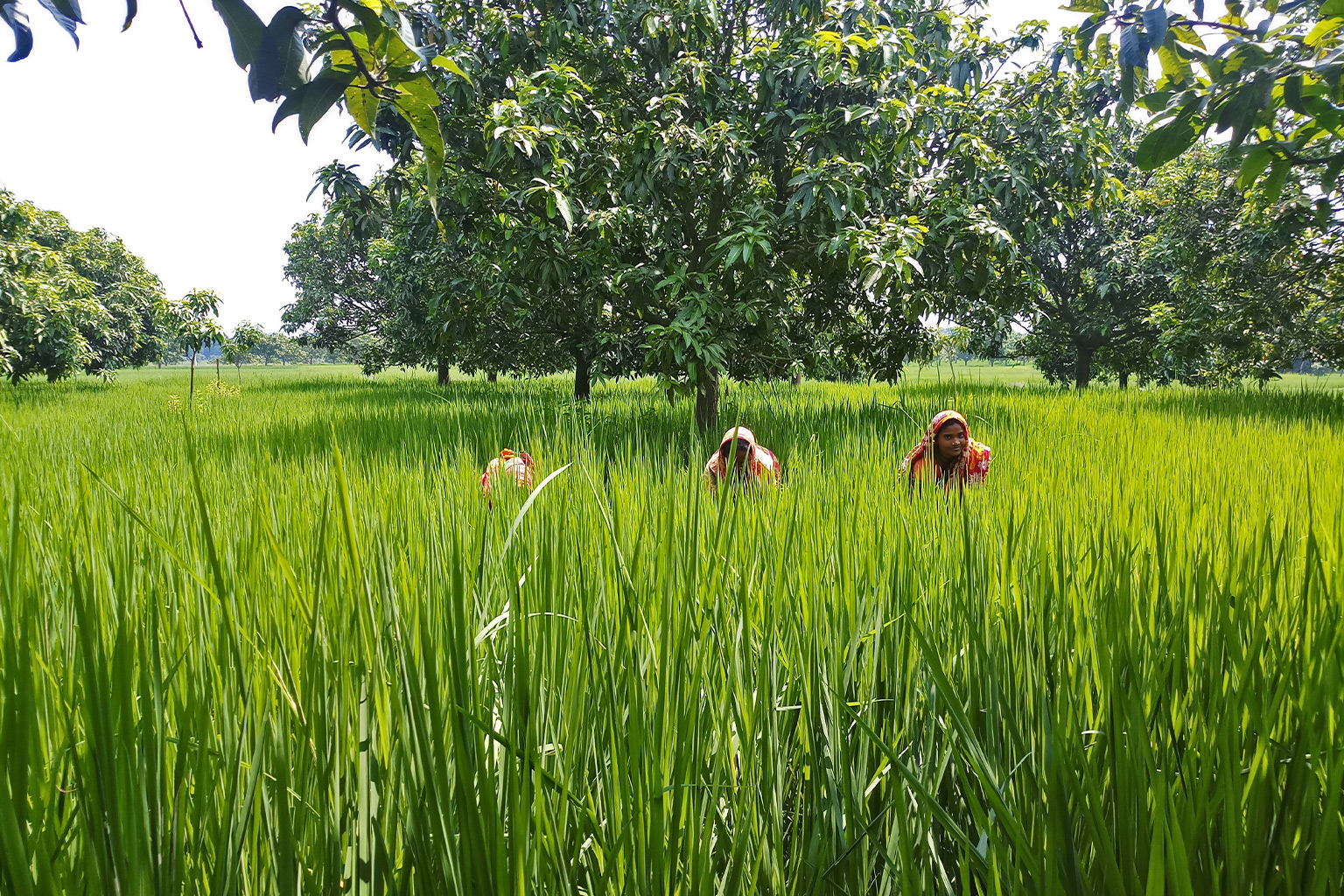- An average of four people a week are killed by lightning in Bangladesh, and the problem is expected to get worse as climate change increases the frequency of lightning strikes.
- Most of the victims tend to be farmers and fishers, who, like members of other poor communities around the world, are bearing the brunt of climate change impacts.
- The Bangladesh Meteorological Department has rolled out an early-warning system, based on modeling developed in collaboration with NASA, that it says will provide up to 54 hours’ warning of potential lightning strikes.
- But experts say the communities most in need of these alerts are those who don’t have access to the technology, and have called for other measures, such as building lightning arresters in open fields and wetlands, to protect vulnerable communities.
DHAKA – On July 30 this year, Moza Mia took his two buffalo out to graze in the field near his home in Bangladesh’s northern Lalmonirhat district. Soon after, lightning struck, and Moza, 52, was killed instantly, along with his two buffalo.
Two days earlier, Jain Uddin, a farmer in Sunamganj, in the country’s northeast, was working in his field in front of his home when lightning struck, also killing him on the spot. Also in Sunamganj that day, Tera Mia, a fisherman, was killed in a strike while fishing in a wetland near his village.
Death by lightning is a relatively common phenomenon in Bangladesh. According to the country’s Department of Disaster Management, 2,164 people were killed in lightning strikes from 2011 to 2020, or about four people a week.
But this is an underestimate of the true toll, said Gawher Nayeem Wahra, member secretary of the Foundation for Disaster Forum, a coalition of humanitarian NGOs.
“The actual death toll from lightning strikes is much higher than the official figure as the concerned government agency counts lightning death cases only reported in newspapers,” Wahra said.
The Foundation for Disaster Forum estimates 3,273 people were killed in lightning strikes between 2010 and 2021, with 363 deaths in 2021 alone. As of August this year, 228 people have been killed by lightning, according to data from the Save the Society and Thunderstorm Awareness Forum (SSTAF).
Farmers and fishers like Moza and Jain and Tera account for most of the victims, and as is often the case around the world, it’s members of poorer communities who are most at risk as a changing climate threatens to increase the frequency of lightning strikes.

Heightened risk of lightning
Bangladesh is one of the countries most vulnerable to climate change impacts, ranging from rising sea levels to increased water temperature to more frequent and intense cyclones. The changing climate is also driving an increase in lightning strikes by inputting more heat and moisture — the key components required to accumulate energy for lightning — into the atmosphere.
In Bangladesh, lightning strikes generally take place during the monsoon and pre- and post- monsoon seasons, and this window is widening due to changing weather patterns. That translates into more days in the year during which lightning strikes are likely.
The rising temperature is also a factor: A 2014 study in the U.S. projected that with every rise in the average global temperature of 1° Celsius (1.8° Fahrenheit) increases the frequency of lightning by 12%. In Bangladesh’s northern Rangpur district, the average temperature increased by 1.2°C (2.16°F) between 1984 and 2013, according to a 2018 study. Thunderstorms and lightning strikes in the area have increased in frequency during this period.
Another study, from 2021, shows that lightning strikes have a positive and statistically significant relation with climatic variables like temperature, rainfall, humidity and air pressure. It warns that lightning strikes may become more frequent in Bangladesh.
The Bangladesh Meteorological Department (BMD) is disseminating live maps using numerical models, indicating the most potential lightning-prone areas. The red areas are considered most likely to be struck by lighting.
Early-warning system
The Bangladesh Meteorological Department (BMD) recently adopted an early-warning system, known as a high-impact weather assessment toolkit, or HIWAT, to more accurately forecast thunderbolt and lightning strikes. It says the toolkit, part of a collaboration with NASA, will allow it to issue an advisory up to 54 hours before a lightning strike.
“Since 2016, lightning strikes have been increasing in Bangladesh. Taking this into account, BMD introduced the HIWAT to issue more accurate operational forecasts,” Abdul Mannan, a meteorologist at the BMD’s Storm Warning Centre, told Mongabay.
The system builds on weather data going back 20 years. By applying numerical modelling, the high impact toolkit can now forecast how many lightning flashes will occur in a specific area, how many flashes will occur every hour and the coverage of a lightning flash in an area.
“The system was integrated into the BMD so that it could provide lightning forecasts within the shortest possible time,” Mannan said.
These forecasts can then be disseminated to the affected regions, where “the people must be made aware of the forecasts,” Mannan said.
However, it’s precisely those people who are most vulnerable to lightning strikes, such as farmers and fishermen, who likely won’t have access to the forecasts generated by the BMD, experts say.


“Those who work in open fields or catch fish in open waterbodies are affected more. The death toll from lightning strikes is much higher than people dying from natural disasters like cyclone and floods,” said Rashim Mollah, general secretary of the Save the Society and Thunderstorm Awareness Forum.
According to an SSTAF report, farmers accounted for 122 of the 177 people killed in lightning strikes across Bangladesh between March 31 and June 7 in 2021. Of 228 killed as of Aug. 18 this year, 145 were farmers and 29 were fishers.
“Death from lightning mainly happen to people who work in the outdoors, and yet there is no location- and time-specific warning system for the local level community in Bangladesh,” said Mohan Kumar Das, a climate scientist at the Bangkok-based think tank Regional Integrated Multi-Hazard Early Warning System.
Farmers and fishers tend to be poor and have no alternative but go out daily to earn a livelihood, even in adverse weather conditions, said Wahra from the Foundation for Disaster Forum.

‘Take shelter’
With climate change set to increases the frequency of lightning strikes, experts say the Bangladesh government should introduce further steps such as lightning arresters to reduce people’s vulnerability and loss of lives to the phenomenon.
One initiative the government is already taking is to plant palm trees along roads, which would effectively serve as lightning rods in the absence of other tall structures. But Wahra said it will take time to see any results from this project, as the trees need a long time to grow to full height.
Experts have also called for lightning arresters to be installed in open fields and wetlands in the absence of trees.
“Lighting arresters can be installed on electric poles too, and Nepal has already had remarkable success in the Terai region by setting up such arresters,” Wahra said.
Without such measures, vulnerable populations are essentially on their own. Mannan from the BMD said people should take shelter in safe places if they see flashes in the sky, as lightning usually starts striking the ground 30 minutes to an hour after cloud-to-cloud flashes start.
“When black clouds [cumulonimbus] accumulate in the sky, cloud-to-cloud flashes start,” he said.
“If farmers working in open fields or fishermen in rivers and wetlands stop work for 30 minutes and go take shelter upon spotting black clouds in the sky, they will be able to protect themselves from potential lightning strikes.” the meteorologist said.
Banner image: Fishermen going out to the river in Banglaesh. Image by Rafiqul Islam.
Citations:
Romps, D. M., Seeley, J. T., Vollaro, D., & Molinari, J. (2014). Projected increase in lightning strikes in the United States due to global warming. Science, 346(6211), 851-854. doi:10.1126/science.1259100
Chakravorti, B. K., Sarkar, P., Rahman, A., & Rahman, A. (2018). Thunderstorm and lightning: The temperature effect on climate change of Rangpur region in Bangladesh. Science Journal of Energy Engineering, 6(2), 31-36. doi:10.11648/j.sjee.20180602.11
Mazumder, A., Sikder, M. B., Islam, M. S., Haque, M. M., & Talukder, S. H. (2021). Lightning in Northeast Bangladesh: Relation with climatic variables, consequences and adaptation. Journal of Tropical Resources and Sustainable Science, 9(2), 103-111. doi:10.47253/jtrss.v9i2.784
Das, M. K., Das, S., Karmakar, S., Islam, A. K., Khan, M. J., & Chowdhury, M. A. (2017). Simulation of dynamical features of squalls over Bangladesh during the pre-monsoon season. The Journal of NOAMI, 34(1), 39-55. Retrieved from https://bit.ly/3BsbOUN
Rahman, M. M., Nabila, I. A., Sakib, M. S., Silvia, N. J., Galib, M. A., Shobuj, I. A., … Islam, A. R. (2022). Knowledge, attitude, and practices towards lightning in Bangladesh. Sustainability, 14(1), 448. doi:10.3390/su14010448
Feedback: Use this form to send a message to the author of this post. If you want to post a public comment, you can do that at the bottom of the page.
